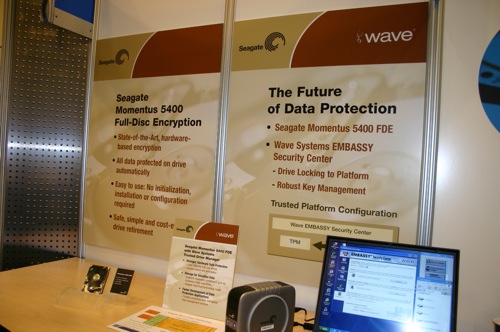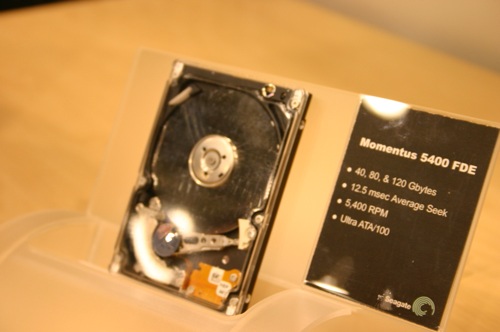Fall IDF 2005 - Day 1: Coverage of Everything
by Anand Lal Shimpi on August 24, 2005 2:31 AM EST- Posted in
- Trade Shows
Seagate's Momentus 5400 FDE - Real Time Hardware HDD Encryption
Seagate was proudly displaying their Momentus 5400 FDE (Full-Disk Encryption), a 2.5" hard drive with an ASIC on the PCB that performs real time encryption and decryption of data on the drive from the minute you plug it in.
Seagate claims that the encryption/decryption ASIC imposes no performance penalty on the drive itself, even during times of peak sequential transfer rates.
The encryption engine is active when you first turn on the drive and begin using it, although no encryption key is generated (the drive comes with a factory-installed key that is inaccessible by the user). A derivative key (not the actual encryption key) can be generated by manually setting the ATA password field, the password is cryptographically combined with the encryption key to create a derivative key that is stored in non-addressable memory, making the encryption key accessible. Wave Systems' Embassy security center was on display as an application that could be used to manage security settings of the FDE drive:
Software like Embassy can make backing up and gaining access to encrypted disks on different computers possible and seamless.
Seagate plans to ship the Momentus 5400 FDE in the first quarter of next year, although no pricing information has been announced. As of now Seagate is only committing to releasing the drive, any third party security software would have to be purchased separately.













14 Comments
View All Comments
jediknight - Wednesday, August 24, 2005 - link
What encryption algorithm does the Seagate drive use? And is it firmware-upgradeable?smn198 - Thursday, August 25, 2005 - link
I'd like moredetails on this. If you've got an OS installed and no key yet, could you then add a key and have it re-encrypt the data or would you need to pull the disk out and do this from another system? Shame Seagate won't ship software. Is there anything free?missleman - Wednesday, August 24, 2005 - link
BONZI BUDDY?!?!?! WTF? I cant beleive intel was stupid enough to install that on their computers.JarredWalton - Wednesday, August 24, 2005 - link
Maybe it was a demonstration of malware getting installed on one virtual OS, and then another OS could detect it and remove it? I know Intel has talked about using virtualization for virus-related stuff before, so it's not too much of a stretch.Hacp - Wednesday, August 24, 2005 - link
Also nice to see the Xbox360... I'm not gonna buy one.xsilver - Wednesday, August 24, 2005 - link
is amd moving to ddr2 and then m2 sockets in a 2 stage process?if so that's pretty evil -- makes users upgrade twice
JarredWalton - Wednesday, August 24, 2005 - link
No, M2 is DDR2 for desktops. S1 is DDR2 for the mobile sectore. F is for the server/workstation market. All are DDR2-only solutions, and there will be no DDR2 support without a socket transition.IamTHEsnake - Wednesday, August 24, 2005 - link
Mitosis looks promising indeed.It's technologies like this that intrigue me. This is more of what Intel should focus on, not just the brute computational strength of mhz or pipeline stages.
I am also looking forward to hearing more about die-stacking and DRAM-on-die.
Furen - Wednesday, August 24, 2005 - link
Yes, mitosis sounds nice indeed (though I'd expect it to be worthless on tasks like gaming), hopefully the software overhead wont be too bad by the time we start seeing it.phaxmohdem - Wednesday, August 24, 2005 - link
One has to wonder in Re: to Mitosis...They say that it is just started in Research and Development, and that we may not see if for 5-10 years..... By then wouldn't all apps be written to take advantage of multithreading? Thus rendering Mitosis a day late and a dollar short?